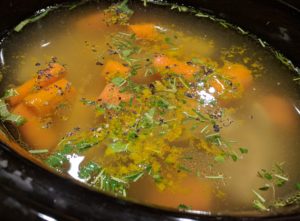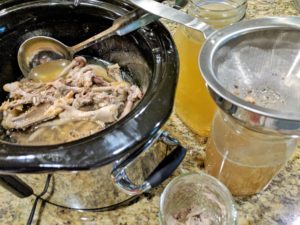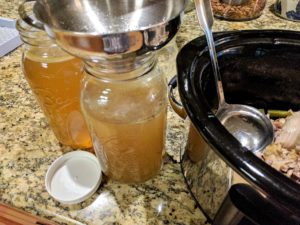Homemade Chicken Bone Broth: Delicious and Nutritious

A homemade chicken bone broth can be a wonderfully nutritious, but it’s also a great flavor enhancement for your everyday meals. With minimal cost and effort, you can get access to loads of flavor and a serving of good health too.
Your Why
I imagine that if you’re reading this post, you might be a busy home manager and chief cook in your household. Maybe cooking comes easy to you and you’re exploring new options. Or maybe you are just starting to cook.
At the same time, maybe you’re wanting to kick it up a notch on the level of what supports good health. Building up defenses against stuffy noses, trips to the doctor’s office, and missed work and school. and the healthiest futures possible for everyone in your household as influenced by daily meals?
Well. Making homemade broth just might be one of those additions you want to consider adding to your routine. It’s not difficult to make and also not too time-consuming to prepare. Choosing to cook your broth slowly gives the ingredients time to release their flavor and nutrients that you can, in turn, access when you incorporate broth into your cooking. By making your own, you’re in charge of the ingredients that go into your broth, so no surprises. And the richer flavored homemade broth will definitely add flavor to your favorite dishes.
Health: Moving Up the Priority List
 Before being diagnosed with Hashimoto’s Thyroiditis, eating healthy wasn’t actually a priority. Like many others, my decisions were based on:
Before being diagnosed with Hashimoto’s Thyroiditis, eating healthy wasn’t actually a priority. Like many others, my decisions were based on:
- Price
- Time and effort to prepare
- Family approval
I assumed that the options on grocery store shelves were basically fine with some being a little better. Of course, there were some that should only be eaten in moderation and some that just tasted gross. Beyond that, I thought our common food choices rated okay as far as health was concerned.
Then came that diagnosis, and I realized that there were basically two paths.
- Take the medications and keep doing everything else without change, or
- Discover what areas I might want to change to support my health and Do It.
I really considered that diagnosis. I also took a good look around me at so many unhealthy people. Lastly, I took in a few of the typical commercials on TV. I’m sure you’ve seen them with smiling, happy people enjoying life now that they’re taking some medication. Of course, while you’re distracted, the narrator softly and speedily runs through the numerous side effects of the drug you are being pushed to ask for at your next doctor’s appointment, so you can be happy too. Uhh. What?
I decided to do whatever I could to support my healing but also set my family on a healthier path wherever possible. My goal was and is to nourish and take care of the bodies we’ve been gifted with.

Chicken Bone Broth Praises
As I started to consider food’s role in health, the importance of eating real food kept coming up. In the midst of those praises, expert after expert referenced bone broth as a part of their recommendations. Some experts even shared their personal strategies to support their health and how bone broth was part of their regimen.
I guess it really shouldn’t be surprising since broth has been around for centuries. It’s common in the traditional cooking and/or farm-to-table movement. You’ll find it’s a staple in numerous healing plans including the Gut and Psychology Syndrome (GAPS) protocol by Dr. Natasha Campbell-McBride and the Wahls’ Protocol by Dr. Terry Wahls just to name a few. Numerous health experts also praise broth benefits in dealing with autoimmune, gluten sensitivity, blood sugar balance, energy, and more.
If you have a good quality, homemade bone broth you are getting huge amounts of gelatin, glutamine, glucosamine, minerals…you’re getting all of these very gut healing, joint healing, connective tissue healing nutrients in a way that’s easy to digest that pretty much anybody, no matter how sick they are, can tolerate.
Liz Lipski PhD, CCN, CNS, CHN, LDN, CFM
Broth Ingredient Choices and Benefits
The better the ingredients, the more nutritious the broth, so whenever possible, and as your resources and access allows, build your broth with:
- nutrient dense vegetables that are preferably organic and non-GMO
- filtered water, and
- bones from animals that have spent their lives eating their natural diet…in this case…bugs, seeds, and greens.
Small bones have a slightly different nutrient makeup compared to larger bones. For this reason, I try to include those wings and feet along with the drumsticks and backbones.

When choosing to eat what our bodies actually recognize and can use, good health and function is supported. And when you make your own food, you have more control of what you and your family eat.
It’s generally explained that the longer the broth cooks, the higher the nutrient level. The presence of vinegar is also reported to pull more minerals out of the bones. Nutrients commonly present in broth include collagen, amino acids, and many minerals, such as magnesium and phosphorus. A few of the areas where benefits might be noticed include:
- hair, skin, teeth, and nail health
- immune function/protection
- internal organ function
- digestive absorption, healing and protection against toxins and other problems
- joint and bone health
- detoxification
If making broth becomes routine, let me also point out a few other potential benefits that might otherwise go by unnoticed:
- eliminating the expense of buying canned/boxed/packaged soups, broths, and gravy mixes
- gaining access to nutrients that you already pay for (when you buy chicken) but haven’t been previously accessing
- making broth once and then using in multiple meals
- increasing options and speeding up the meal preparation process
- supporting health for you and your family
- lowering your exposure to some of the questionable ingredients that are commonly present in packaged foods
Just an FYI
Be aware, however, that if you or someone you cook for have challenges with histamines and/or glutamine in particular, you may want to consider cooking for a shorter length of time and/or not including the vinegar as both of these can draw more out and into the broth.

Enjoy a soothing, warm cup of broth or incorporate into your favorite meals.
- 1-2 Carcasses Chicken bones Pasture-raised preferred
- 1-2 Quarts Filtered water
- 2 Tablespoons Apple Cider Vinegar
- 1 Onion Skin and scar removed, quartered
- 2-3 Carrots Peeled and ends removed, chopped
- 2 Stalks Celery Tips removed, chopped
- 2-4 Cloves Garlic Skin and scar removed, quartered
- Herbs Bay leaf, thyme, etc.
- 1-2 Tablespoons Real Salt
- 1/2 Tablespoon Peppercorns Crushed
- 1 Teaspoon Turmeric
-
Place your chicken bones, water, and vinegar in your pot or slow cooker and let sit while you add other vegetables of your choice.
-
Set your stove or crockpot for low and slowly cook for 2-12 hours.
-
Skim off and discard any grayish/brownish scum that appears on top while cooking.
-
Add herbs, salt, pepper, and turmeric approximately one hour before done.
-
When cooking is done, turn off cooker or stove, let broth cool, and then strain out the broth into your container of choice.
-
Strain and serve immediately or let it cool and then refrigerate.
-
Freeze any broth that remains after 4 days after cooking. Freezing in ice cube trays and then moving to a closed container make for easy access in adjustable amounts.
- Other than the chicken bones and water, all other ingredients are basically optional including the vinegar. Include what ingredients you prefer and have available.
- If you decide to cook your broth on the stove, be sure to cover but watch and keep the bones completely immersed.
- Use salt sparingly to avoid over-salted meals.
- I recommend organic, non-GMO vegetables, and pasture-raised, bug/seed/grass eating chickens. Check out area farmers' markets and Local Harvest for resources in your area. Also check out the "Clean 15" and "Dirty Dozen" lists on Environmental Working Group for more information.
Sources
I’ve gathered all that you might need to purchase to make broth together.
- Apple Cider Vinegar
- Natural Salt
- My exact Crockpot (but there are many brands with different characteristics)
- 2 2-Quart, Wide-Mouthed Mason Jars
- Freezer Trays
- Peppercorns
- Turmeric
Most of these can be bought at your local grocery store, but I’ve linked most of the above items to Azure Standard, since they a great source for buying clean items in different amounts, including bulk amounts. Azure Standard is one of my favorite resources, aside from local sources. I also find Vitacost to be a good source for certain items.
Please note: If you decide to store your broth in 2-quart jars, you need to plan to use it quickly or store it differently and freeze a portion of it. (see Storage info. below)
Time Investment
This nutrient-dense, multi-meal resource is really a pretty minimal time investment. For what it might take to sit in line at a drive-through 1-2 times, you’ve gained use of a tasty ingredient. And don’t forget, other than the time it takes you to set up, check up, and clean up, the slow cooking goes on while you’re busy elsewhere or maybe even sleeping.
Depending on how much chicken you typically cook for any given meal, you can freeze bones until you have collected enough for a broth batch. Chicken bone broth is one of the shortest broth cook times that I’ve seen, usually ranging from 6-12 hours, and a health-supporting ingredient that can be easily added to most meals. For this reason, I try to always have broth ready and in the refrigerator or freezer.
My preference is to cook a good amount of chicken at one time that will last through multiple family meals and save us some time and effort. Then before the meal is served, the meat is stripped off the chicken bones and those bones are immediately dropped in my water-filled stock pot or slow cooker set at low, unless I’m freezing them for later use. If I’m doing this before our evening meal, this gives me a few hours of cooking time and an opportunity to skim any scum off the top of the broth before bedtime. Don’t forget to add frozen chicken bones, if you decide you need them plus any supplemental parts like necks and feet to pump up the nutrients, and other chosen ingredients.

Chicken Bone Broth Storage & Convenience
Ahh…you’ll love waking up to the delicious smell of broth. Once cooled, we strain the broth into mason jars that fit well in the wide door shelves of my refrigerator without taking a lot of shelf space. There are a variety of recommendations as to how long your broth will keep in the fridge. To play it safe, we transfer any remaining broth to ice cube trays to freeze after 4 days in the refrigerator and then transfer the cubes to sealed containers. The frozen chicken bone broth cubes have worked well too, allowing a quick and convenient grab of whatever amount is needed in preparing the next delicious meal.
You will definitely see me talk more about broth in future posts. It’s often an integral part of our favorite recipes, or alone as a soothing brothy soup with a few green onion slices tossed in and some crunchy crackers on the side.
Are you thinking about how you’ll incorporate it into you family favorites? I hope you enjoy making your own chicken bone broth, and the flavors that come through.
Have fun creating and enjoying.

